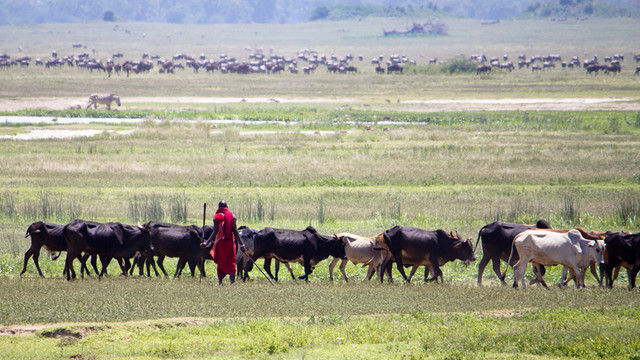Climate adaptation needs urgent philanthropy support
Tom Mitchell and Heather McGray suggest why now is the time for philanthropies to advance their ambitions for climate justice by becoming climate adaptation champions.



Farmer using drip irrigation in India, where, in 2022, some states lost a third of their crop yield (Photo: Hamish John Appleby/IWMI via Flickr, CC BY-NC-ND 2.0)
Climate change, once seen as a threat to our future, is now understood as the crisis of our time. An estimated US$260 billion was lost to extreme weather globally in 2022, with 106.9 million people affected by drought alone.
In Nigeria, 1.5m people were displaced by floods exacerbated by climate change. In India, temperatures exceeded 50°C; some states lost a third of their crop yield. In places like coastal Bangladesh and the Horn of Africa, whole territories are losing their ability to sustain livelihoods like fishing, farming and herding.
In response to the urgency of this challenge, philanthropy has increased funding for mitigation – action to curb greenhouse gas emissions – every year since 2015. Mitigation is necessary for a climate-safe future, but it does not address the very real challenges of people facing this crisis right now.
Injustice is at the heart of climate change. Those contributing least to this crisis bear the brunt of the impacts, with 69% of deaths worldwide caused by climate-related disasters over the last 50 years occurring in least developed countries. Further, those already marginalised within countries – including women, youth, Indigenous Peoples and people with disabilities – are usually most negatively affected.
Philanthropy can step in to address injustice and ensure climate action solves people’s most pressing climate problems. Growing funding for approaches that build resilience to climate change now is critical to avoid massive losses.
Climate funding is failing those on the front lines
There is some good news: people can build resilience using many straightforward adaptation measures, such as replanting deforested slopes to prevent landslides or painting buildings white to reflect heat.
Yet communities suffering most often have the least access to the resources they need to build resilience. Even if the money pledged for adaptation at COP26 reached the countries that need it most, it would only equate to $11 per person per year.
Too often though, monetary pledges don’t materialise; of those that do, bureaucracy and an obsession with big infrastructure mean only 10% reaches those living in the most climate-impacted areas. Worse, a 2021 assessment of climate adaptation projects found that many create new sources of vulnerability and exacerbate injustice by not working with and through affected communities to address their challenges and concerns.
Climate funding, therefore, fails those on the front lines in three ways:
- Very little of it is allocated to their needs to start with
- Of that, only a fraction reaches them, and then
- Much of that fraction supports counter-productive activities.
This is a major opportunity for philanthropy to make an impact.
A way forward for just and effective climate action
Adaptation efforts that increase resilience and follow climate justice principles seem a natural fit for climate philanthropists, who typically have a strong moral compass, show a willingness to tackle the big challenges, and are nimbler and often more agenda-setting than publicly funded bodies.
We call on philanthropy to grow its support for adaptation and resilience, and to do so in ways that foster equity and justice.
Starting points for this much-needed shift include:
1. Commit to best practice
More than 100 government and civil society organisations have endorsed a framework of principles for locally led adaptation (LLA), which were formulated by the countries and communities on the front lines of the crisis.
The principles include commitments such as supporting long-term capability-building, devolving decision-making to the most appropriate local level, and uplifting the voices of women, youth, Indigenous Peoples and others often left on the margins.
The values and priorities of many philanthropic actors are well-aligned with the LLA principles. More philanthropies should endorse and apply these principles in their work.
2. Demonstrate innovation in quality and access to money
Too many international climate funding mechanisms have been designed to fit in with the norms and processes of major funders, not the needs and priorities of communities. Philanthropy is well positioned to show how money can move fast, respond to local needs and drive transformative outcomes.
For example, CJRF’s board is now formed of practitioners and activists – rather than funder representatives – and is developing a grantmaking strategy informed by their lived experience and on-ground knowledge.
3. Support a systems and portfolio approach
The tendency has been to support single adaptation projects with pre-determined outcomes – for example, building higher riverbanks to prevent flooding. But narrowly framed projects can miss important system linkages and therefore backfire, as when lack of flooding degrades soil quality or when raised embankments worsen flooding when rivers overtop them.
Philanthropy can invest in projects that are designed and led by local people, who bring deep knowledge of a place to the table, and support integrated portfolios that ensure interventions work together to build a more resilient overall system.
This points to a new, portfolio-based approach to funding climate resilience, one now being adopted by the EU Adaptation Mission and tested by philanthropies like the UBS Optimus Foundation. While a single philanthropy would likely not finance an entire portfolio, it can put its money into core funding of catalytic actors.
Building resilience is possible
In 2021, 15 countries formed the Champions Group on Adaptation Finance to increase and improve finance for adaptation. We want to see philanthropies take a similar step: joining forces on climate adaptation to drive justice and change, beginning with the steps listed above.
A group of adaptation and climate justice champions within philanthropy can advocate for better finance quality and access, highlight and scale innovations and work together to achieve transformative climate resilience.
The group would be most impactful if it embraces deep partnerships with affected communities, with members making a commitment to apply good practice principles and work together. The group also could become a strong voice in international climate discussions and work in collaboration with states and the private sector.
People striving to thrive amid climate destruction have been waiting for philanthropy to join hands with them on adaptation, and with the other sectors already at the table. Now is the time.
This blog was originally published on Alliance's website.


